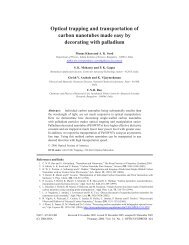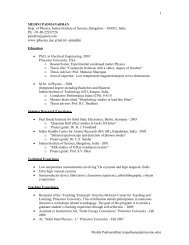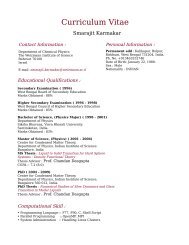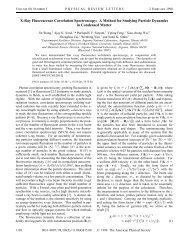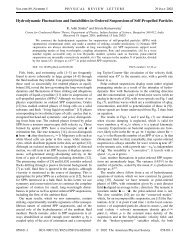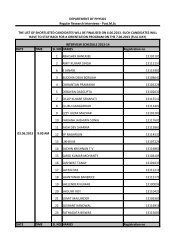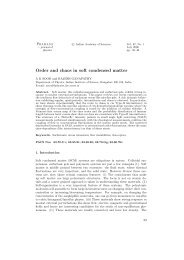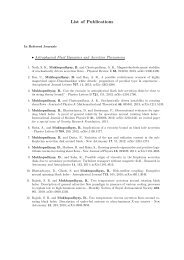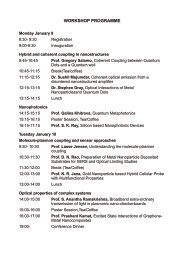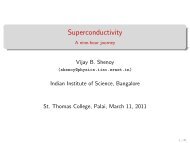C. Usha Devi, R. S. Bharat Chandran, R. M. Vasu and A.K. ... - Physics
C. Usha Devi, R. S. Bharat Chandran, R. M. Vasu and A.K. ... - Physics
C. Usha Devi, R. S. Bharat Chandran, R. M. Vasu and A.K. ... - Physics
Create successful ePaper yourself
Turn your PDF publications into a flip-book with our unique Google optimized e-Paper software.
<strong>Devi</strong> et al.: Mechanical property assessment of tissue-mimicking phantoms…<br />
modulation of the detected intensity or amplitude<br />
autocorrelation. 11 The depth of modulation is influenced by<br />
the local absorption coefficient of the medium insonified by<br />
the US beam. This result added an extra dimension to DOT<br />
imaging, allowing the possibility of spatial resolution improvement<br />
of absorption coefficient images by discarding all<br />
detected diffuse photons except those tagged by ultrasound.<br />
The flurry of activity in this direction saw the arrival of a new<br />
branch of DOT known as ultrasound-assisted optical tomography<br />
UAOT. 12–14<br />
However, it was only recently that the influence of the<br />
local microrheological properties of the turbid medium on the<br />
UAOT measurement which is the depth of modulation of the<br />
intensity or amplitude autocorrelation has been investigated.<br />
Since the US beam subjects the scattering centers in the object<br />
to an extra periodic stress, in addition to the thermal stress,<br />
the modulation in the detected photon correlation is also related<br />
to the amplitude of vibration of the scattering centers.<br />
This amplitude, in turn, is influenced by the local visco-elastic<br />
properties. 15 In Ref. 15 it is shown that the depth of modulation<br />
in the autocorrelation is influenced by the amplitude of<br />
vibration u of the scattering centers <strong>and</strong> n the modulation of<br />
the refractive index because of insonification, in addition to<br />
the local absorption coefficient. In fact, the phase modulation<br />
suffered by light owing to n <strong>and</strong> u results in modulation of<br />
the detected intensity, providing a carrier whose amplitude is<br />
influenced by the local absorption coefficient in the region of<br />
insonification through multiplication.<br />
In Ref. 15 it is pointed out that if the UAOT read-out is to<br />
be employed for a quantitatively accurate recovery of either<br />
the optical or elastic properties of the object, the influence<br />
each of these has on the modulation depth has to be first<br />
estimated <strong>and</strong> accounted for. Out of these, the contribution of<br />
absorption can be independently estimated, by reconstructing<br />
the absorption coefficient distribution using the established<br />
DOT reconstruction algorithm on the measured intensity autocorrelation<br />
g 2 at =0, which is the same as the intensity<br />
data. The remaining contributions are from refractive index<br />
fluctuations n <strong>and</strong> the path length fluctuations u. We<br />
show in this work that the displacement introduced by the<br />
focused US beam in the region of insonification is along the<br />
axis of the US transducer. Therefore, assuming that tissue-like<br />
material has a scattering anisotropy g of 0.9 light scattering<br />
is forward directed, the path length modulation <strong>and</strong> its<br />
variation with elastic property picked up by light launched<br />
perpendicular to the US transducer axis is small compared to<br />
that picked up by light along the transducer axis. This variation<br />
is negligible for storage modulus above 50 kPa, which<br />
is slightly above the normal value of healthy breast tissue. 16 In<br />
addition, it is shown through simulations <strong>and</strong> experiments that<br />
the modulation in g 2 for light launched along <strong>and</strong> perpendicular<br />
to the US axis approach the same constant pedestal<br />
value as the storage modulus of the material is increased beyond<br />
80 kPa. This value of storage modulus is dependent<br />
also on the power input through the US transducer. When the<br />
radiation force from the US force increases, significant displacement<br />
components still influence the g 2 modulation<br />
depth, much beyond the 80-kPa limit of the present experiments.<br />
This implies that for such large stiffness, the displacement<br />
of tissue particles introduced by US radiation force is<br />
negligibly small, <strong>and</strong> the contribution to modulation in g 2 <br />
is entirely because of n j j , where j is the average undisturbed<br />
scattering path length in the insonified region. This<br />
pedestal value to which the g 2 modulation approaches is<br />
the same for both axial <strong>and</strong> transverse light interrogation, in<br />
spite of the fact that the length of interaction for these two<br />
cases is not the same. The axial length of the US focal region<br />
is approximately four times its width at the center see Sec.<br />
2. But the path length modulation that can be picked up in<br />
diffusing wave spectroscopy has a maximum value of , the<br />
wavelength of the interrogating light. 17 For this reason the<br />
g 2 modulation depth in the two directions of interrogations<br />
approaches the same value when the storage modulus is large.<br />
This residual value, which is insensitive to storage modulus<br />
variations for storage modulus beyond 50 kPa for transverse<br />
illumination <strong>and</strong> 80 kPa for axial illumination, is the contribution<br />
from n. This means that for other values of storage<br />
modulus, wherein the g 2 modulation has contribution from<br />
both displacement <strong>and</strong> n, the contribution from n can be<br />
subtracted out, <strong>and</strong> the modulation arising entirely out of displacement<br />
of scattering centers can be ascertained. This paves<br />
the way for retrieving the displacement components induced<br />
by the US force from measurement of g 2 modulation<br />
depth, which can be used for quantitative reconstruction of the<br />
storage modulus.<br />
As a consequence of the previous observation, we suggest<br />
through this study that the absorption coefficient map obtained<br />
from g 2 modulation depth in an UAOT experiment<br />
is least likely to be affected by storage modulus variations<br />
which certainly accompanies malignant regions along with<br />
absorption coefficient increase when the interrogation light is<br />
perpendicular to the US transducer axis <strong>and</strong> the insonification<br />
is from a focused US transducer. In this case, the contribution<br />
to g 2 modulation depth from displacement is significantly<br />
less <strong>and</strong> varies very little with storage modulus. The summary<br />
of the work reported here is as follows. In Sec. 2 the force<br />
distribution in the focal region of the US transducer is calculated<br />
by solving the Westervelt equation 18 for the input parameters<br />
of the transducer <strong>and</strong> the acoustic properties of the phantom<br />
used in the experiments later. The force distribution is<br />
used in the forward elastography equation in Sec. 3, which is<br />
solved for the tissue-mimicking phantom, assuming it to be<br />
purely elastic. It is seen that the estimated displacement distribution<br />
is along the US transducer axis. Section 4 describes<br />
the simulation of propagation of photons through the insonified<br />
phantom. The goal of the simulation is the estimation of<br />
g 2 <strong>and</strong> its modulation. Photons are transported both along<br />
<strong>and</strong> perpendicular to the axis of the US transducer. Section 5<br />
reports the experimental verification of the simulations on<br />
special tissue-mimicking phantoms. In this section, the results<br />
of simulation are compared with the corresponding experimental<br />
results. In Sec. 6 the results are discussed, <strong>and</strong> Sec. 7<br />
puts forth the concluding remarks.<br />
2 Force Distribution in the Focal Region<br />
of the Ultrasound Transducer<br />
The object, which is a slab of tissue-mimicking material, is<br />
insonified by radiation from a focusing US transducer. The<br />
tissue particles in the focal region are set in vibratory motion<br />
by the force of the US beam. In this section, our objective is<br />
Journal of Biomedical Optics 024028-2<br />
March/April 2007 Vol. 122



